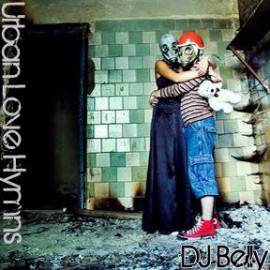 Let’s clear one thing up right now — dubstep scares me. It seems like the movement is predicated on taking dance music to its most frightening and sinister conclusion. And listening to “You’re a Deadman” off of DJ Belly’s new album Urban Love Hymns does nothing to calm my fears. The song is like a fever dream that I would only dance to in my David Lynch-themed nightmares. But after listening to the album a few times, I found myself looking forward to those nightmares.
Let’s clear one thing up right now — dubstep scares me. It seems like the movement is predicated on taking dance music to its most frightening and sinister conclusion. And listening to “You’re a Deadman” off of DJ Belly’s new album Urban Love Hymns does nothing to calm my fears. The song is like a fever dream that I would only dance to in my David Lynch-themed nightmares. But after listening to the album a few times, I found myself looking forward to those nightmares.
Urban Love Hymns is not instantly catchy; it’s an album that grows more interesting and more revealing with each listen. As expected, the bass is mesmerizing and volume is a necessity. But instead of using the dubstep genre as a crutch, Belly uses it as a starting point to craft distinct soundscapes. Despite sampling Sublime, Cat Power, Missy Elliot, MIA, David Banner and others, Belly is mostly able to put his unique stamp on all of the songs. Each song feels part of the larger whole, but also often work as individual jams.
Rather than plopping a couple of interesting noises over rattling bass, the songs are thick with experimentation. “Pan Tempei” takes flute sounding sample, lets it float along and the songs builds from there. It has a light feeling, but heavy undertones with vocals coming in at the right times. “Ridin Slow” seems like it’s going to be the ultimate slow jam, but then it throws out all pretense of being any sort of dance song and becomes an electronic backwards jazz song.
As I expected, faraway female vocals are present on several songs, but they do not devolve into cliché. When they kick off “Where’s My Summer in Love” I instantly know exactly where this bit of low end R&B is going. But DJ Belly’s unpredictability rears its head again. The “chorus” of the songs is based around a sound that aurally resembles someone hanging up, and it never sounds annoying. In fact, it’s downright hummable.
About twenty seconds into “the Battle,” the bottom drops out. It’s hard to explain exactly what happens next, but the title might be a reference to some giant automobile-based robots having some sort of futuristic fight. And it manages to pack more entertainment into three and a half minutes than both Transformers movies combined. The album’s highlight is surely “Rough and Tumble,” which dips into a lot of different wells. It’s based around an Eastern sounding riff that comes in and out of the mix. But what sets it apart is how easily it blends its dubstep origins with a rock ‘n roll mindset. Surely, this song gets the dance floor moving.
There are a few lows to go along with all of these highs. “Watcha Doin” is disappointing only in its conventionality. It sounds too much like a dub remix of the original song it’s sampling — MIA singing “Watcha Doin” is the most memorable part of both songs. “Together as One” has some spooky talk vocals over eerie synths. While it works with the overall feel and flow of the album, as a song it bores me. And it seems unnecessary that two versions of “Dublin Step” are included. I’m not sure why the original version is kept, when the “VIP mix” seems clearly superior to me. Other than that, there’s not much else to complain about.
The most interesting part of Urban Love Hymns all is how effortless it feels. Belly bends the samples to his needs and it never feels forced. Music like this doesn’t just happen. It’s clear that Belly was incredibly meticulous in his choices, as he had to choose among several versions of each song. He told me that the definitive versions of the songs are what made the album. He said he worked on most of the songs for over six months. And you can tell.
So is Urban Love Hymns a great dubstep album? I have no idea. For all I know, it’s not even technically a dubstep album. But I do know that it’s a pretty great way to spend 45 minutes.
(BTW – DJ Belly is giving this away for free; you can get it here.)
— — — —
In doing background research for this review, I asked Belly about his process in creating an album, as opposed to a mixtape or a live mix. I found his response quite revealing:
I try to really make each song invoke some sort of reaction in the listener, whether it be physical, emotional or mental. When looking at the songs I chose to release as this album, I tried to find a common theme of downtempo styled tracks and “mood scapes”, if you will. Each track is supposed to invoke feelings of warmth, love, angst, anger, familiarity and whatever emotion the listener feels when they hear it.
And here he is explaining why he decided to give the album away for free:
I don’t really make music to make money. I make music as a way to channel various aspects of emotional situations I am going through at the time of the inception of the song. I look at this particular project as a very emotionally charged thing as it was something made while going through some difficult changes in my life so there is no way I would try and package and sell something like that.








